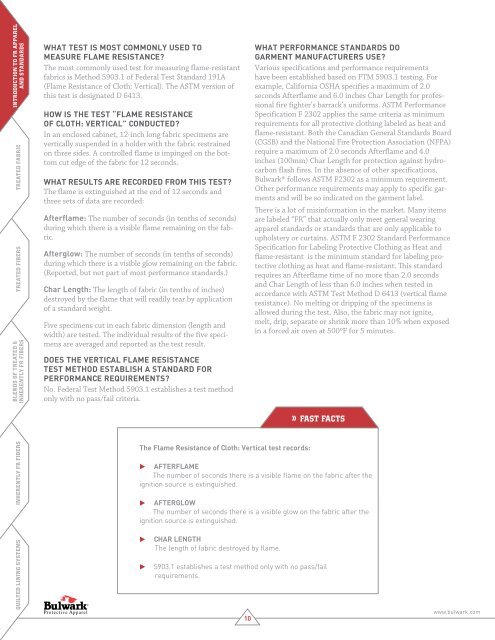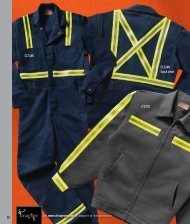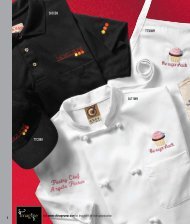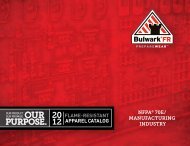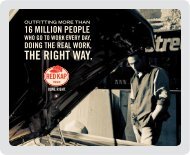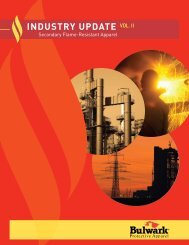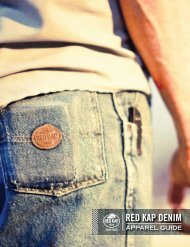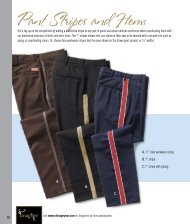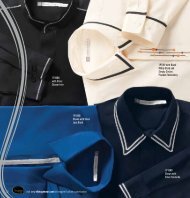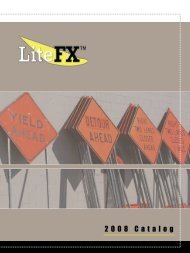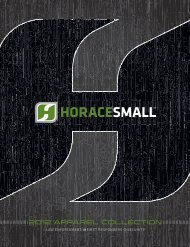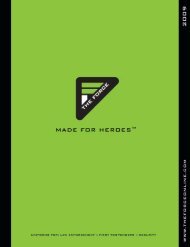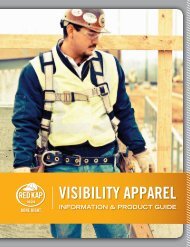VOL. 10 - Red Kap Work Clothes, Uniforms, & Coveralls
VOL. 10 - Red Kap Work Clothes, Uniforms, & Coveralls
VOL. 10 - Red Kap Work Clothes, Uniforms, & Coveralls
You also want an ePaper? Increase the reach of your titles
YUMPU automatically turns print PDFs into web optimized ePapers that Google loves.
introduction to fr apparel<br />
and standards<br />
treated fibers treated fabric<br />
BLENDS OF TREATED &<br />
INHERENTLY FR FIBERS<br />
What test is most commonly used to<br />
measure flame resistance?<br />
The most commonly used test for measuring flame-resistant<br />
fabrics is Method 5903.1 of Federal Test Standard 191A<br />
(Flame Resistance of Cloth: Vertical). The ASTM version of<br />
this test is designated D 6413.<br />
How is the test “Flame Resistance<br />
of Cloth: Vertical” conducted?<br />
In an enclosed cabinet, 12-inch long fabric specimens are<br />
vertically suspended in a holder with the fabric restrained<br />
on three sides. A controlled flame is impinged on the bottom<br />
cut edge of the fabric for 12 seconds.<br />
What results are recorded from this test?<br />
The flame is extinguished at the end of 12 seconds and<br />
three sets of data are recorded:<br />
Afterflame: The number of seconds (in tenths of seconds)<br />
during which there is a visible flame remaining on the fabric.<br />
Afterglow: The number of seconds (in tenths of seconds)<br />
during which there is a visible glow remaining on the fabric.<br />
(Reported, but not part of most performance standards.)<br />
Char Length: The length of fabric (in tenths of inches)<br />
destroyed by the flame that will readily tear by application<br />
of a standard weight.<br />
Five specimens cut in each fabric dimension (length and<br />
width) are tested. The individual results of the five specimens<br />
are averaged and reported as the test result.<br />
Does the vertical flame resistance<br />
test method establish a standard for<br />
performance requirements?<br />
No. Federal Test Method 5903.1 establishes a test method<br />
only with no pass/fail criteria.<br />
What performance standards do<br />
garment manufacturers use?<br />
Various specifications and performance requirements<br />
have been established based on FTM 5903.1 testing. For<br />
example, California OSHA specifies a maximum of 2.0<br />
seconds Afterflame and 6.0 inches Char Length for professional<br />
fire fighter’s barrack’s uniforms. ASTM Performance<br />
Specification F 2302 applies the same criteria as minimum<br />
requirements for all protective clothing labeled as heat and<br />
flame-resistant. Both the Canadian General Standards Board<br />
(CGSB) and the National Fire Protection Association (NFPA)<br />
require a maximum of 2.0 seconds Afterflame and 4.0<br />
inches (<strong>10</strong>0mm) Char Length for protection against hydrocarbon<br />
flash fires. In the absence of other specifications,<br />
Bulwark® follows ASTM F2302 as a minimum requirement.<br />
Other performance requirements may apply to specific garments<br />
and will be so indicated on the garment label.<br />
There is a lot of misinformation in the market. Many items<br />
are labeled “FR” that actually only meet general wearing<br />
apparel standards or standards that are only applicable to<br />
upholstery or curtains. ASTM F 2302 Standard Performance<br />
Specification for Labeling Protective Clothing as Heat and<br />
flame-resistant is the minimum standard for labeling protective<br />
clothing as heat and flame-resistant. This standard<br />
requires an Afterflame time of no more than 2.0 seconds<br />
and Char Length of less than 6.0 inches when tested in<br />
accordance with ASTM Test Method D 6413 (vertical flame<br />
resistance). No melting or dripping of the specimens is<br />
allowed during the test. Also, the fabric may not ignite,<br />
melt, drip, separate or shrink more than <strong>10</strong>% when exposed<br />
in a forced air oven at 500ºF for 5 minutes.<br />
» FAST FACTS<br />
quilted lining systems INHERENTLY FR FIBERS<br />
The Flame Resistance of Cloth: Vertical test records:<br />
u AFTERFLAME<br />
The number of seconds there is a visible flame on the fabric after the<br />
ignition source is extinguished.<br />
u AFTERGLOW<br />
The number of seconds there is a visible glow on the fabric after the<br />
ignition source is extinguished.<br />
u<br />
u<br />
CHAR LENGTH<br />
The length of fabric destroyed by flame.<br />
5903.1 establishes a test method only with no pass/fail<br />
requirements.<br />
<strong>10</strong><br />
www.bulwark.com


